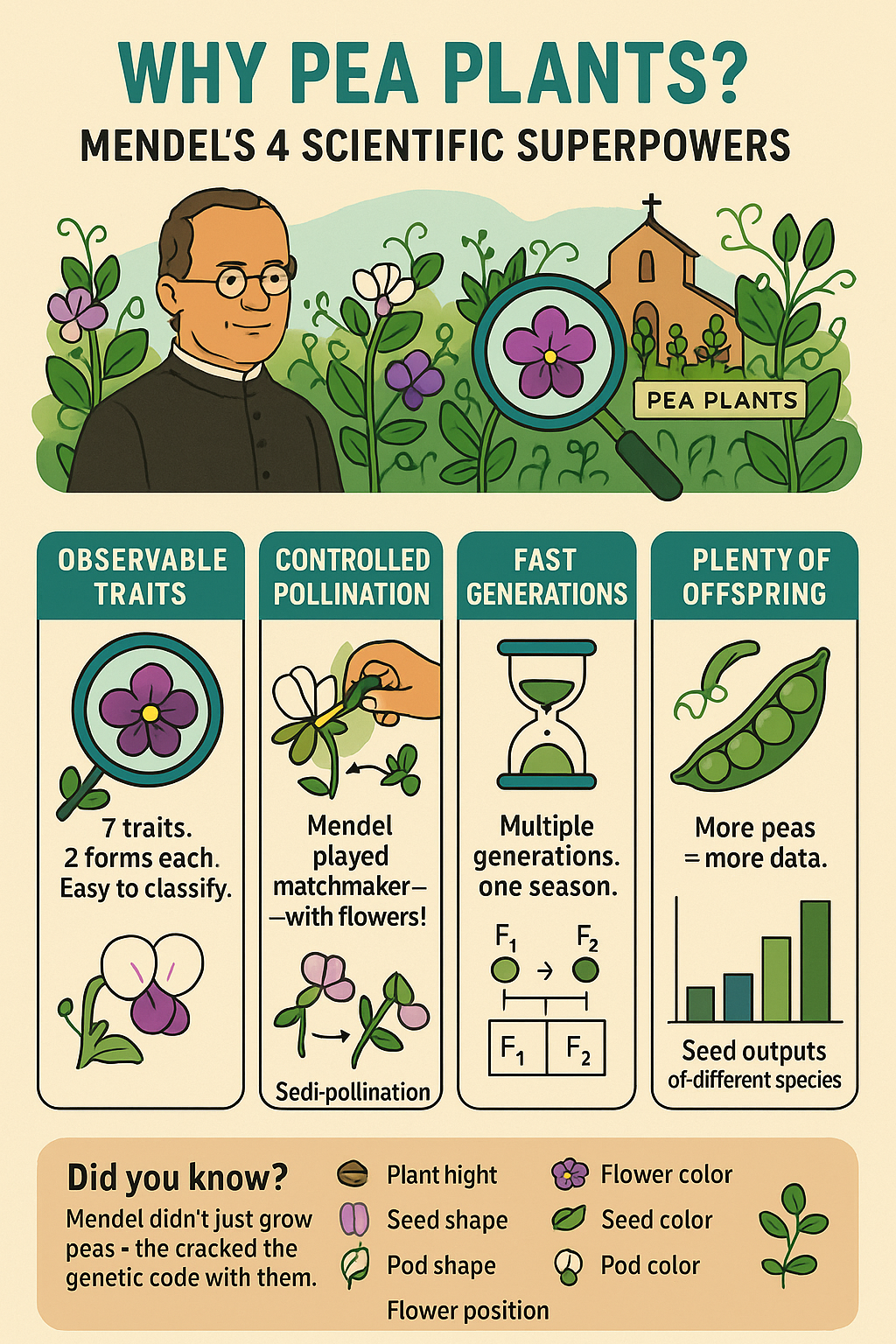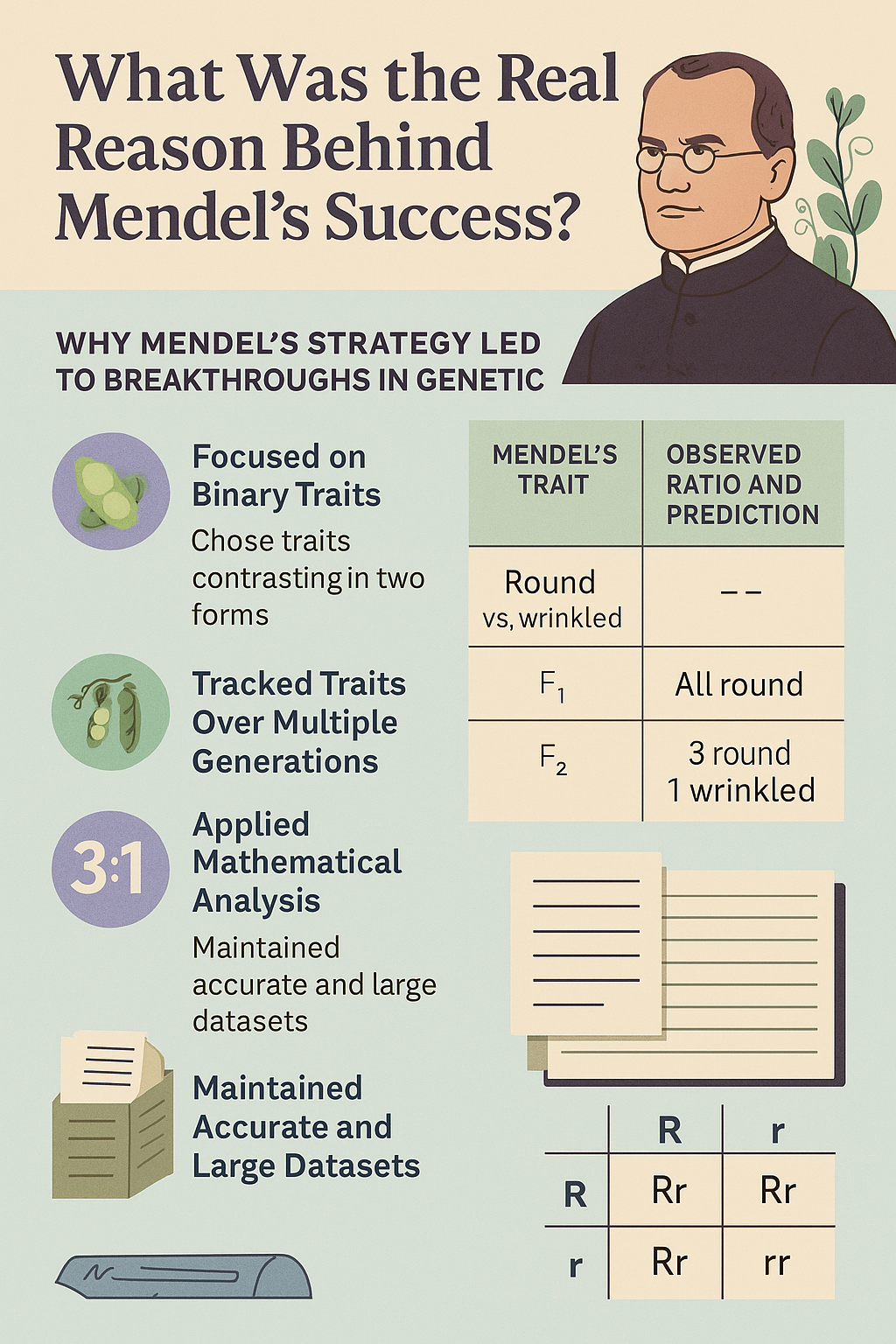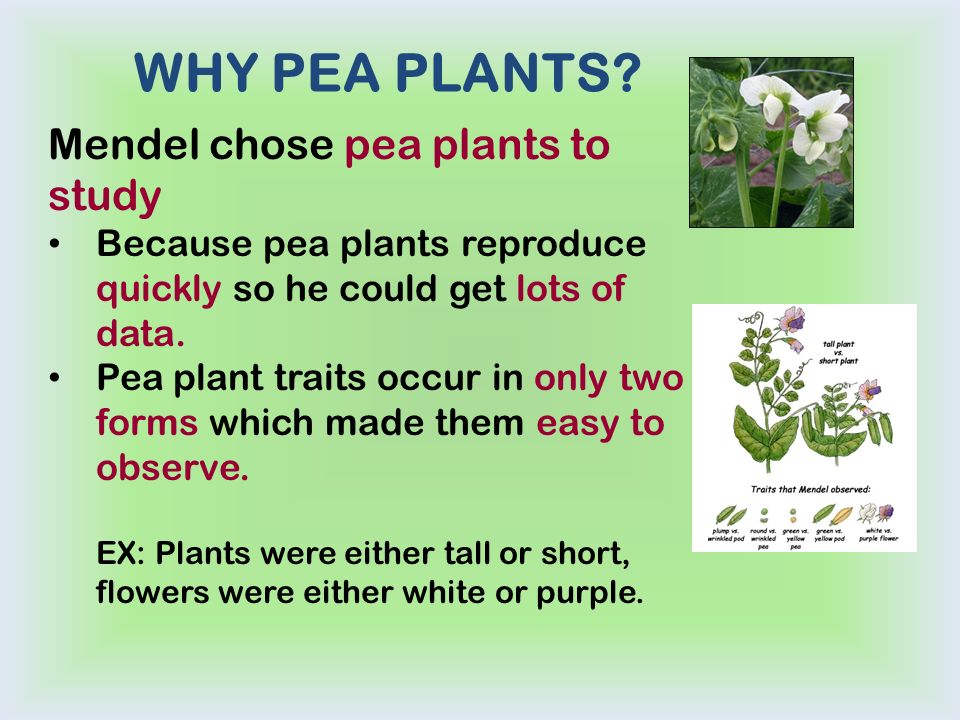What Made Pea Plants Ideal for Mendel’s Experiments?
Quick Answer: Mendel studied pea plants because they offered the perfect combination of biological simplicity and experimental control. Their distinct, binary traits (like tall vs. short), short generation time, and ease of cultivation made them ideal for observing inheritance patterns. Most importantly, pea plants allowed Mendel to apply mathematical analysis to biology—a groundbreaking approach at the time. Their ability to self- and cross-pollinate gave him precise control over breeding, enabling the discovery of fundamental genetic laws that laid the foundation for modern genetics.

Key Reasons Why did Mendel Study Pea Plants
Gregor Mendel didn’t choose pea plants (Pisum sativum) by chance—he selected them with scientific precision. These plants offered multiple biological advantages that made them ideal for discovering how traits are inherited across generations. Here’s why:
Easily Observable Traits
Pea plants exhibit clear, contrasting physical characteristics—such as purple vs. white flowers, round vs. wrinkled seeds, and tall vs. short stems. These traits were not only easy to spot with the naked eye but also consistently passed on in predictable ways, making data collection straightforward and accurate.
Ability to Self-Pollinate or Cross-Pollinate
Pea plants have both male and female reproductive organs, enabling them to self-pollinate naturally. However, Mendel could also manually cross-pollinate them by removing the stamens and transferring pollen himself. This flexibility gave him complete control over breeding experiments—something crucial to maintaining purity of lines and studying specific trait inheritance.
Short Generation Time
With a fast life cycle, Mendel could observe multiple generations within a single growing season. This allowed him to track trait inheritance from parents to offspring over time, accelerating his research and enabling statistically meaningful conclusions within a few years.
Large Number of Offspring Per Generation
Each cross produced dozens to hundreds of seeds, providing Mendel with large sample sizes. This abundance of data allowed him to identify patterns, calculate ratios (like 3:1 and 9:3:3:1), and establish the foundational principles of heredity.
💡 Fact Box
Did you know? Mendel experimented with 7 distinct traits in pea plants, including:
- Plant height (tall vs. dwarf)
- Flower color (purple vs. white)
- Seed shape (round vs. wrinkled)
- Seed color (yellow vs. green)
- Pod shape (inflated vs. constricted)
- Pod color (green vs. yellow)
- Flower position (axial vs. terminal)
Each of these traits had two contrasting forms, which made it easier to apply mathematical analysis and observe inheritance laws.
The Scientific Method Behind Mendel’s Pea Plant Experiments
What was the reason for the selection of the pea plant in Mendel’s experiments?
Gregor Mendel wasn’t merely planting seeds — he was laying the foundation for modern genetics through rigorous scientific methodology. His choice of the pea plant (Pisum sativum) wasn’t just practical, it was profoundly strategic. Pea plants offered everything an experimental biologist could ask for: precision, control, repeatability, and observable results.
Related
What Was the Primary Finding of the Minnesota Study of Twins Reared Apart?
How Has the Study of Mitosis Affected Scientists’ Knowledge of Cancer?
Why Pea Plants Were Perfect for Controlled Experiments
Mendel Could Isolate Traits One at a Time
Each trait in pea plants appeared in clear-cut binary forms — such as tall or short, green or yellow. This made it easy for Mendel to design experiments focusing on one variable at a time, a gold standard in scientific testing.
Used Purebred Lines for Accuracy
Mendel began with true-breeding plants, meaning each generation consistently showed the same traits. This allowed him to establish baseline data and identify when new traits emerged — revealing the hidden mechanics of heredity.
Easy to Grow and Manage in Monasteries
Pea plants required minimal space, resources, and supervision, making them ideal for long-term observation. Mendel grew and documented over 28,000 plants within the monastery’s limited garden space — a testament to both the plant’s practicality and his dedication.
🧠 Pull Quote:
Mendel wasn’t just lucky. He was methodical, precise, and years ahead of his time in experimental design.
In science classrooms around the world — from India’s CBSE labs to Ontario’s high schools in Canada, and even in Nigerian STEM programs — pea plants continue to be used as a model organism for teaching genetics. Their simplicity and reliability make them just as powerful today as they were in Mendel’s 19th-century garden.
🧪 Try It Yourself: Cross two pea plant traits and track them through an F1 and F2 generation. You’ll be replicating the very process that launched an entire field of science.
What Was the Real Reason Behind Mendel’s Success?

Search-style subheading: What was one reason for Mendel’s success with genetic studies of peas?
Mendel’s success in uncovering the principles of heredity wasn’t just about using the right plant—it was about using the right process with exceptional discipline. His groundbreaking findings were the result of scientific rigor, mathematical insight, and an unshakable commitment to clarity and data accuracy.
Here’s why Mendel’s pea plant experiments were more than just good gardening:
Why Mendel’s Strategy Led to Breakthroughs in Genetics
Focused on Binary Traits
Mendel deliberately chose traits that existed in two clear, contrasting forms—such as round vs. wrinkled seeds or tall vs. dwarf plants. This helped him easily categorize results and spot patterns in inheritance.
Tracked Traits Over Multiple Generations
He didn’t stop at observing parent-offspring relationships. Mendel tracked traits over multiple generations (F1, F2, F3…) to understand how they reappeared, disappeared, and recombined.
Applied Mathematical Analysis
Mendel introduced quantitative reasoning to biology—a novel approach at the time. He used ratios (like 3:1 and 9:3:3:1) to identify consistent patterns and develop predictive models for inheritance.
Maintained Accurate and Large Datasets
Over 8 years, Mendel cultivated more than 28,000 pea plants. This gave his conclusions statistical strength and allowed him to spot anomalies that smaller experiments might miss.
Published Clear and Replicable Findings
His 1866 paper, “Experiments on Plant Hybridization,” wasn’t flashy—it was methodical. It laid out his methodology so clearly that modern geneticists can still replicate it today.
Summary Answer
What was one reason for Mendel’s success with genetic studies of peas?
Mendel succeeded because he combined a simple, well-controlled experimental system with precise data collection and mathematical analysis, allowing him to uncover consistent patterns of inheritance.
How Mendel’s Pea Plant Research Transformed Genetics
Why did Mendel carry out an experiment to study inheritance?
Gregor Mendel’s curiosity went far beyond simple gardening. In a time when most people believed that traits from both parents blended evenly in their children, Mendel dared to ask a different question: Could traits be passed down as independent, predictable units? His experiments with pea plants weren’t just botanical—they were revolutionary.
By crossbreeding pea plants and tracking traits across generations, Mendel laid the scientific groundwork for the field of genetics—decades before the word even existed.
Why Mendel’s Research Marked a Turning Point in Science
Challenged Existing Theories of Inheritance
Before Mendel, theories like “blending inheritance” dominated science. People believed offspring were simply a mixture of parental traits. Mendel showed instead that traits were inherited as discrete units, now known as genes.
Formulated the Laws of Inheritance
Through his work, Mendel established what would later be called:
- The Law of Segregation – Traits separate independently during reproduction.
- The Law of Independent Assortment – Different traits are inherited independently from one another.
Used Experimental Evidence, Not Guesswork
Mendel didn’t rely on guesswork or observation alone. He used data, ratios, and patterns to support his theories. This made his work not just insightful, but also scientifically credible and replicable.
Ignored in His Time, Celebrated in Ours
Although Mendel published his findings in 1866, they went largely unnoticed for over 30 years. In 1900, his work was rediscovered by scientists like Hugo de Vries and Carl Correns—ushering in the modern era of genetics.
Why did Mendel carry out an experiment to study inheritance?
Mendel conducted his experiments to understand how traits were passed from one generation to the next. He discovered that traits are inherited in predictable patterns, leading to the foundational principles of genetics.
Pea Plants in Modern Science and Classrooms
Why are pea plants still used in genetics today?
More than 150 years after Mendel’s groundbreaking experiments, pea plants continue to play a central role in teaching and understanding genetics. Their simplicity, predictability, and historical importance make them a model organism for both basic biology education and advanced genetic research.
Whether you’re a middle school student building your first Punnett square or a university researcher exploring gene expression, Pisum sativum still earns its place in the lab.
Why Mendel’s Pea Plants Are Still Relevant Today
Ideal for Demonstrating Mendelian Inheritance
Pea plants still exhibit the same binary, visible traits that Mendel studied—making them perfect for classroom activities and hands-on labs. Their genetic simplicity allows students to clearly observe dominant and recessive traits, generation by generation.
Used in Genetics Simulations and Software
Digital biology tools like Punnett square simulators and gamified genetics platforms often use pea plants to model inheritance. This keeps Mendelian concepts accessible and interactive for today’s tech-native learners.
Low Maintenance, High Learning Value
Pea plants are inexpensive, quick to grow, and easy to manage in small lab setups. Schools and universities across the world—from CBSE schools in India to U.S. community colleges—still rely on them for high-impact, low-cost genetic demonstrations.
Connects History with Modern Science
Teaching Mendel’s experiments with real pea plants bridges historical context and modern applications, helping students see how one monk’s curiosity still drives scientific discovery today.
Why are pea plants still used in genetics today?
Pea plants are still used because they have clear, inheritable traits, grow quickly, and are easy to manipulate in experiments—making them ideal for teaching and studying basic genetic principles.
Conclusion
Gregor Mendel’s decision to study pea plants wasn’t just a matter of convenience—it was a masterstroke in scientific design. The unique combination of observable traits, controlled breeding, short life cycles, and abundant offspring made Pisum sativum the perfect organism to unravel the laws of inheritance.
But what truly set Mendel apart wasn’t the plant—it was the process. His methodical experimentation, mathematical rigor, and clear documentation elevated plant breeding into the realm of genetics, giving rise to a field that now touches every corner of science, medicine, and agriculture.
Today, from biology classrooms to genetic labs, Mendel’s legacy lives on—not only through the laws that bear his name but through the very plants he once cultivated in a monastery garden. His pea plants remain a timeless symbol of how simple questions, when paired with curiosity and precision, can change the world.
Frequently Asked Questions (FAQs)
1. Why did Mendel decide to use pea plants to study inheritance?
Mendel chose pea plants because they had easily distinguishable traits, a short generation time, and the ability to self- or cross-pollinate. These characteristics allowed him to control breeding and observe trait inheritance across multiple generations.
2. Which is a reason Mendel chose to study pea plants?
One reason is that pea plants exhibit clear, binary traits (like tall vs. short or round vs. wrinkled seeds), which made it easier for Mendel to track how specific traits were passed down.
3. What was the reason for the selection of the pea plant in Mendel’s experiments?
Pea plants were selected because they are simple to grow, produce many offspring, and offer high experimental control. Mendel could isolate and test one trait at a time using purebred lines.
4. What is the reason for Mendel’s success in his experiments with pea plants?
Mendel’s success was due to his methodical approach, including using pure lines, focusing on single-variable traits, collecting large datasets, and applying statistical analysis to interpret inheritance patterns.
5. What was one reason for Mendel’s success with genetic studies of peas?
He succeeded because he treated biology like a science of numbers—using ratios and large sample sizes to uncover patterns in trait inheritance that no one had seen before.
6. Why did Mendel carry out an experiment to study inheritance?
Mendel wanted to understand how traits are passed from one generation to the next. His experiments helped disprove the blending theory of inheritance and introduced the concept of discrete hereditary units, now known as genes.

